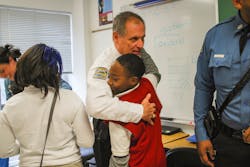After the Protest - Q&A with Ferguson's Lt. Col. Alan Eickhoff
It has been two years since the protests following the Michael Brown shooting. For the most part, the dust has settled. A grand jury found there was no probable cause to indict police officer Darren Wilson in the death of Michael Brown. Yet, the town continues to see occasional protest, particularly on the event’s anniversary. As time goes on protesters, community members and the police force all continue to see (and create) change based on these events. For the police force in particular, manpower is currently down but smart community policing strategies are on the upswing.
We talk with Ferguson Lt. Alan Eikhoff about what type of support officers received during and after protests, where officer morale stands now, and how building bridges can help to support a new Ferguson.
LET: Lt. Eikhoff, what significant changes have you seen take place on your force in the last two years?
AE: Right now the most significant thing is…after today, I’m now 16 officers short out of a 55-man department. And we’ve been reduced down to 52 through budget cuts. I think a lot of the morale issues that we’re dealing with is that people are having to work extra shifts to cover the beats (volunteer your days off and stuff)—so that’s still playing on it. I have a couple of officers who still have some issues with everything that happened during the violence and protests and anger and…we’re giving them counseling.
But the big thing is the overall impact on everybody. This thing went on and on and on and now in two weeks we have the anniversary of the grand jury decision. So you have to gear up extra people anticipating some of these guys who protest or want to have a peaceful demonstration, because sometimes a peaceful demonstration can turn violent. During the last couple protests we’ve had gunfire. So you always have to anticipate that. You can have the most peaceful demonstration—you can have 100 people outside your station and it’s all great. Then one person brings a gun, one guy brings a Molotov cocktail or lawn darts (we’ve had those thrown at us too) and all it takes is one or two people to get in that crowd and now everything turns ugly. When you have 100 people, how do you find the one person who’s throwing the bottles and rocks, or shooting the gun?
Even though most of it’s over, it’s not gone. And I don’t know how long it will be before it’s gone from the community.
LET: Describe the toll the protests took on officers and their families.
AE: The first round we had was 160 days of continuous protest. Every day we had some kind of protest on our streets, in our parking lot, somewhere in the city. And when you have other departments helping you (I had municipal officers here, St. Louis County here, highway patrol), they at least had a break where they could go back to their departments and get away for a while. During that time [our] guys were here every day facing anger and people who hated their guts, and after a while that just kind of wears on you. It breaks you down.
One of our biggest support groups was the Police Wives [Association]. During all the protests these ladies were feeding 300 to 500 officers a day at each breakfast, lunch and dinner. What was nice about it was the officers got a break from everything outside; they were able to come into a safe, friendly environment. Some of them saw their own wives who were working for the association. That gave them a lot of relief, and sometimes it gave them a chance to get things off their chest.
The chaplains were very big; we had a lot of support from the churches and people bringing volunteers in.
LET: Describe how your community policing efforts have changed over time.
AE: So we’ve lost a few officers, but we’ve got a lot more community involvement. We’ve always had neighborhood watches, and now we’re seeing them get larger. The officers are more involved. We’re kind of changing things around. The officers now have permanent sectors—so they get more involved as the “owner” of that sector and it’s my job to keep it safe as possible, cut down the crime, and get more involved with stopping by the schools and talking to the kids. We’re trying to get our officers to get more involved with the kids. Anything where we can get more involved with the community.
The problem I had since I lost a lot of officers is I have less officers to be involved with the community. Chief Moss came from Florida where he had the PAL program (Police Athletic League), and we’re trying to get that going, where we have officers who will be coaches and sponsors of teams and mentors of the kids out on the fields, whether it be baseball, basketball, and soccer, whatever.
LET: Do most of your officers ride single patrol?
AE: We are all single-man officers. We do have an occasional bike patrol when we have special events. The big thing you’ve got to do is get the officers out of the cars and past that door. The door’s like a barrier. If I can get them out of the car, then you get more face time with everybody and let them know we’re human, too. Now that things are quieter, the community’s events are a lot larger. We just had a Halloween event where we set up candy booths in front of the police and fire departments and had [500 kids come for] Halloween candy.
LET: About how many of those protesters would you say were local? How many do you continue to work with? How has your relationship with them evolved?
AE: Right now I can tell you that I could probably name about 8 to 10 of the activists; some of them live in Ferguson, some live in the St. Louis area 5, 10 minutes away…and they’re still very active. They come to the council meetings, they come to events; some have their demands. Some are on the police steering committee. But when you have a protest you’re generally looking at anywhere from 30 minimum to sometimes 100 or 125.
When this all first started some of the activists just absolutely hated us. Over the last 6 months to year we’ve bridged those gaps. We’re talking, we’re more sociable to each other, and when something happens in my community—whether it’s a shooting or something—I’m on the phone texting saying “hey, it’s not involving police. This is what’s going on.” I keep them informed. On the other hand, when things are happening in the community that I want to know about, I’ll get anonymous calls to me saying “You might want to look at this or this or watch out for this.” We’re trying to work with each other as much as possible to avoid those conflicts
And I think we’re making good progress…we argue back and forth. We agree to disagree. That’s one thing I’m up-front [about]. I’m not always going to agree with you and you’re not always going to agree with me. But we’re talking. You’ve got to keep communicating.
It’s the same with my officers. I’ve been criticized by some of my residents for being friendly with some of the activists. But somebody has to bridge that gap. Somebody has to keep that door open. And some of my residents say, “I see what you’re doing but I can’t agree. Well then we’re going to disagree. Because I think this is important.” Some of the residents will say things like, “We’ve got to get back to the way things were before.” No. We go back to the way things were before, we’ve learned nothing. We need to move forward with the new Ferguson—the more open Ferguson.
Believe it or not, Ferguson had a very high rating with the police department before the shooting. When people talked about Ferguson at one point they thought it would never happen here, but it did. We’re a bedroom community, we’re very integrated, our industries are black and white and Asian…whatever the culture is it’s in each street. But unfortunately there’s an economic side of Ferguson. There’s the one end that’s very well maintained, it’s got a lot of good businesses and stuff. And there’s the other side that faces true economic hardship; some of the businesses have closed up and it’s not doing as well as the other side of the town. So we need economic development to that part.
If we really get down to it and talk to a lot of people about all this, it’s the economic hardship which is facing a lot of our teenagers. No jobs.
LET: Do you find yourself using social media more?
AE: Yes. Definitely more. I still think we’re behind the 8-ball, because some of the people are so good at what they do with social media but yes. Every department’s doing that more now. As soon as you can, get your department out on social media, get your story out. That’s important. I’m a firm believer that if I have video of something that happened, as soon as I can I’m going to make that video available to everybody. Because I think you dig a bigger hole when you try to hide the truth. If it’s an investigation and you’re realizing maybe there’s a problem, I still say do whatever you’ve got to do with the department or that officer or whatever, but you’ve got to get it out there and say this is what happened and this is what we’re doing. If it’s an honest mistake by the officer we are going to fix it. If it’s something intentional then you need to be held accountable.
One thing we’ve learned, and we were even told by chiefs from other cities that had some social issues, “Get ahead of the social network.” We were never used to seeing Twitter and Facebook and what they could do. I could be out front with 20 protesters having a conversation and one of them tweets, “Hey we’re at Ferguson PD right now and we’re having problems.” They went from 20 to 200 in a matter of minutes. And that was something new for all the police departments here. I couldn’t get enough policemen sometimes to get here…they were successfully blocking the streets for 20, 30 minutes before we could get organized. Social media killed us.
The other thing, too, was there was a lot of networks out there that wanted to put their story out. If it bleeds it reads. They weren’t worried about the good stuff, things that we had done that showed the positive light of Ferguson. They always wanted the negative light of Ferguson. And that was a hard lesson for us to learn.
LET: For 2017 I’d imagine you’re thinking about hiring and recruiting again.
AE: Yes. We are in the process of doing that right now. Our recruiting is actually expanding. We’re trying to get to some universities and some of the other training facilities [in the area]. Ideally we like to find somebody who’s already been through the academy because that way we don’t have to put them through (which is 6 months). But if we find good candidates and we like what we see then we will pay for them to go through the academy and they’ll get a salary. I would like to have a minimum two years’ college. Sometimes you get a guy out of the military, he’s got five years’ military and he’s more mature and seems like a sure candidate for you and you’ll probably take him with that military experience. I would just encourage him or reimburse him to go to college while he’s on the job.
We’re looking for outside sources, we’re going anywhere we can. We also consider officers’ recommendations.
LET: Anything else?
AE: Keep your lines of communication open. People ask, “How could you give these activists your cell number?” Well it’s my work phone, it’s part of my job, and you get here in the upper ranks you’ve got to take phone calls at night, you’ve got to talk to people. You’ve got to go to meetings. You sometimes have got to get lambasted by questions and things that you really don’t want to hear and you’ve got to get your part of it back: “Yes, that’s what you’ve heard and this is what really happened.” You’ve got to be the one to debate with people but you’ve got to know your facts. If you don’t know your facts say, “I don’t know that one but I’ll get back to you.” And you need to get back to the people…don’t leave them hanging. This is a community.
Community is everyone together. And you got to have the trust with the law enforcement. A couple times these protesters had violence break out, guess who they were calling. That’s how quickly things change. We’ve seen it over and over here with our protests. We’re the bad guys, but still they need us to be the good guys. As soon as we’re done we’re back to being the bad guys.
But we’ve learned a lot, we’ve moved forward. I think we’re heading in the right direction with this community, everybody…we’re just kind of holding our breath and taking those steps. Baby steps, but we’re taking steps.

Sara Scullin
Sara Scullin was the Editor of Law Enforcement Technology magazine, a monthly business-to-business publication that covers technology trends and best practices for public safety managers. LET is part of SouthComm Law Enforcement Media, which also publishes Law Enforcement Product News and Officer.com. Sara had covered the law enforcement industry since March 2008.



